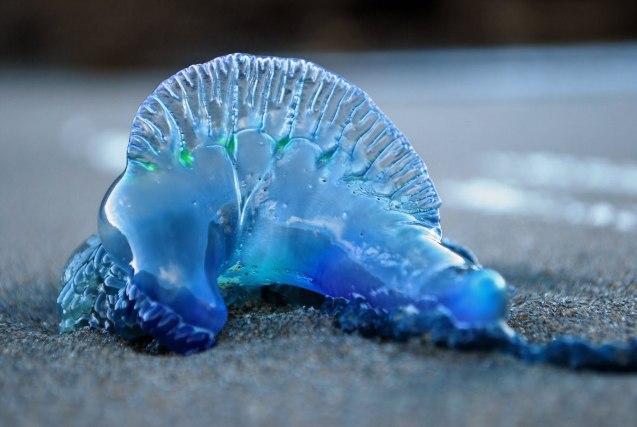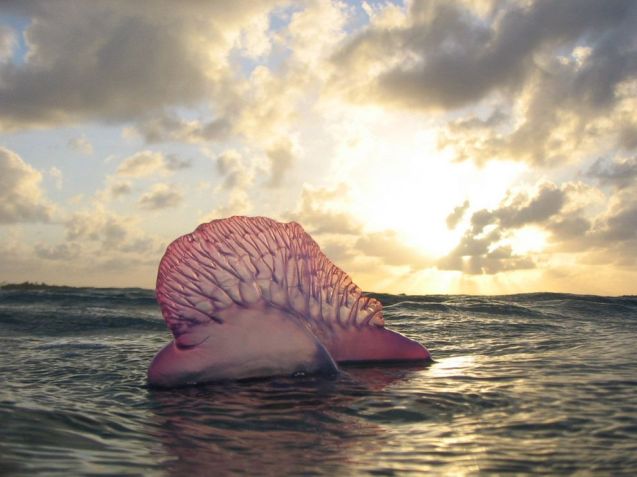Anyone unfamiliar with the biology of the venomous Portuguese man-of-war would likely mistake it for a jellyfish. Not only is it not a jellyfish, it’s not even an “it,” but a “they.” The Portuguese man-of-war is a siphonophore, an animal made up of a colony of organisms working together. They are attached to one another and physiologically integrated to the extent that they are incapable of independent survival.
The man-of-war comprises of four separate polyps. It gets its name from the uppermost polyp, a gas-filled bladder, or pneumatophore, which sits above the water and somewhat resembles an old warship at full sail. Man-of-wars are also known as bluebottles for the purple-blue color of their pneumatophores.
The tentacles are the man-of-war’s second organism. These long, thin tendrils can extend 165 feet (50 meters) in length below the surface, although 30 feet (10 meters) is more the average. They are covered in venom-filled nematocysts used to paralyze and kill fish and other small creatures. For humans, a man-of-war sting is excruciatingly painful, but rarely deadly. But beware—even dead man-of-wars washed up on shore can deliver a sting.
Muscles in the tentacles draw prey up to a third polyp containing the gastrozooids or digestive organisms. A fourth polyp has the reproductive organisms.
Man-of-wars are found, sometimes in groups of 1,000 or more, floating in warm waters throughout the world’s oceans. They have no independent means of propulsion and either drift on the currents or catch the wind with their pneumatophore. To avoid threats on the surface, they can deflate their air bags and briefly submerge. They are most often found in warm, tropical and subtropical waters. However, there have been hundreds of reports of them washing up on beaches in England, Wales and Ireland (Kirkpatrick and Pugh). In general, they can be found in the Atlantic Ocean, Pacific Ocean, Indian Ocean and the Caribbean.
The way these organisms have evolved amuses me! Four different organisms attached together and working as one sounds a lot like some super robot from transformer movie. Only, its real and wayyyy cooler 😀 just see how beautiful it looks!
Photograph by Jennifer Kiewit
Sources : www.nationalgeographic.com




Nature is so badass
It sure is!! 😀
Incredible! And fascinating! 🙂
Thanks a lot 😀
Mad as all get out, aren’t they?
Query. Man of wars or men of war?
one enough for many wars.. so i guess Man of wars 😀
wow, weird looking, weird name…. will keep well clear of this one!
hehe.. Please do.. Their stings are quite painful I’ve heard!
I nominated you for a Very Inspiring Blogger award. http://sarahjanelives.com/2012/11/24/where-did-the-last-week-a-half-go/
Love your stuff!
aww.. thanks a lot Sarah! You are really sweet 😀
So interesting! Thanks for all the details– I never knew any of this.
I’m glad you liked it 😀
Very fascinating
😀
Thank you for sharing. Best, Mtetar
It is my pleasure Mtetar.. Thanks for visiting again 😀
Always welcome. Mtetar
Love the photos! And thanks for the National Geographic description. Very interesting stuff.
😀
It’s so interesting.. thank you Uma!
Glad you liked it 😀
Thank you for the visit.
Such stunning photos.
Very cool Uma. This creature is right out of a science fiction movie. Now all it needs to do is grow big enough to destroy Tokyo or New York.
Maybe next years Halloween costume?
haha.. It would make a really cool Halloween costume! 😀
Wow, that is so cool!!! I’ve heard of man of wars before, but never read about them or seen them!
Just learned something new. Thank you! 😊
It is my pleasure 😀
Beautiful capture of one of nature’s beautiful designs.
😀
Wow! Such an awesome post!
Thank you 😀
Nice picture! It almost looks like something out of sci-fi. By the way, is that a baby man of war in the first picture?
Well I don’t know how to differentiate a baby man o’ war from a grown one.. I’m sorry. may be some one else reading this could enlighten us?
Wow! that’s amazing!…………Paula x
😀
Great post:)
Thank you 😀
What a cool creature! Thanks for enlightening me!
I’m glad you liked it 😀
Great Stuff!
Thank you.. I’m glad you liked it 😀
Another blue monster! I’ve learned so much that I didn’t even know that I wanted to know since I latched onto your blog. Thanks for the ‘like’ on my pre-grump rant today.
hehe. i’m so glad that I helped you learn somethIng new! 😀
And I’m happy to lend and ear.. and thanks for the link to http://myfrenchheaven.com/. It really is a lovely blog!
I read a story that compared the looks of the Portuguese Man o War to a Zip Loc baggie. True. But I also love the detail and photos you provide here.
Thanks for stopping by my blog.
I guess the floating part does look like a Zip lock baggie. It was my pleasure and thanks for stopping by 😀
almost too crazy to be true.
😀
Thanks for stopping by my blog!
Beaaautiful pictures!
By the way,I love the way your site is layed out 🙂
Thanks a lot 😀
Yea it’s beautiful, but It’s a bit scary too.. 😀 Good stuff!
xoxo
Mari from
http://ohyesshesabitchbutnotyours.com/
hehe yea it is.. Admire it from a distance 😀
And you have a lovely blog 🙂
Thank you so much! I’m extremely happy to hear that. 🙂
Hello, Middle Earth!
They are fascinating creatures… I love its colour…!
Me too!! Thank you for dropping by 😀
Hi Uma,
I had to steal the Blue Bottle picture for my 30th post – readers guide to my blog.
My link button seems sticky today, but I did reference it back to you – love your stuff!
RidicuRyder
Thank you RidicuRyder : )
I wish my iPad would have cooperated for linking – sometime its just not in the mood, I really enjoy your stuff. Your Blue monster avatar is the best I have seen so far it always make me happy.
RidicuRyder
Thats ok.. Thank you for mentioning my blog name 🙂
And thank you sooo much for liking my Blue monster 😀
Uma,
Your Blue Monsters make me smile each time I see them
RR
haha.. thats good to know 😀
so nice very interesting
😀 Glad you liked it
Wow, I remember blue bottles from living in Australia, sooo scary. I’ve never been stung by one but I’ve heard some horror stories 😦 It’s creepy when the tide is out and you see them all over the sand.
Great post, really interesting 🙂
Rohan.
wow! its amazing that you’ve seen them. I hope that I’d come across some too.. Of course I’d like to keep some distance though!
I’m really glad you liked the post 😀
that was very cool. and i loved the final shot. the sun is just rising here at the moment where i live and it was neato-keen seeing this picture from either dawn or dusk. nice post. my son and i were riveted. 🙂
I’m really glad you liked it 😀
ps – he loves your gravatar image. i do too. 🙂
haha.. thanks a lottt!!:D
Ohhh shivers, how beautiful!!! 😀
😀
beautiful yet dangerous…nice post Uma….learned something new today and awesome blog btw 🙂
Thanks a lot!!! I’m really glad you liked it 😀
browsing the rest…that Tiger’s Nest monastery kicks ass…i so want to go stay there….
haha.. me too me too.. Its on top of my bucket list 😀
sounds like a plan Uma….what other gems you got tucked away here in your blog me wonders 🙂 Shall peruse and discover 🙂 enjoying it!
They really are beautiful if you can get past their squishy kind of look and those nasty tentacles. I thought it was very interesting to read, also. I love your illustrations. I’m a picture person. Don’t get me wrong, I love to read, but I’m one of those people who wonder why they never illustrate adult books. 🙂
Thanks a lot!! I get you Jean. I’m just like you 😀
Your right ! This is way cooler than transformers WOW 🙂
WOw! I have never seen anything like this before! :O